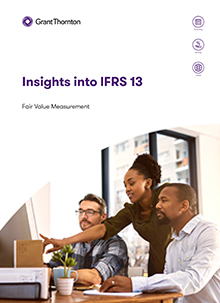-
Sector Focus
We specialise in the investment management industry offering audit, assurance, tax and corporate recovery and liquidation services.
-
Personal Tax Services
There are many tax rules that can affect you personally and therefore which will have an impact on your personal wealth.
-
QI Compliance
Qualified Intermediaries (QI) have to take action now to perform a Certification to the Internal Revenue Service (IRS).
-
Download our tax brochures
The tax teams at Grant Thornton aim to provide the Channel Islands with a premier tax advisory service both to private clients and the business community including the investment management industry.
-
Jersey Tax Return
A secure sign in page to file Jersey Tax Returns through the Grant Thornton tax portal.
-
ESG
ESG can either be seen as a risk management tool or an opportunity, either way it is imperative to your business, whatever your size and whether you are listed or not.
-
Professional Services
Business and accounting support for professional services
-
Finance Industry
We work with a broad range of clients and their financial stakeholders, from entrepreneurs in the early days to fast growing and established businesses to public companies competing in global markets.
-
Local Businesses
Businesses come in many shapes and sizes – from innovative start-ups to long-established local businesses. But however large or small your business, the chances are you face similar challenges.
-
Corporate Insolvency
Our corporate investigation, Guernsey liquidation and recovery teams focus on identifying and resolving issues affecting profitability, protecting enterprise value and facilitating a full recovery where possible.
-
Corporate Simplification
Redundant corporate entities can over complicate group structures and waste thousands of pounds in unnecessary costs each year. 46% of the c.15,500 companies controlled by the FTSE100 are dormant and it is estimated that the average cost of administering dormant companies is between £3,500 and £5,000 per company, per year.
-
Debt Advisory
Our Debt Advisory team provides commercial and financial debt advice to corporate entities and public sector bodies in a range of sectors. Our engagements include advice on stand-alone transactions and solutions or as part of an integrated business plan, in both the project and corporate arenas.
-
Exit Strategy Services
We offer a tailored methodology designed to enable a company to be reviewed in a group context to assess ways to maximise its value.
-
Financial Restructuring
For companies challenged by under-performance we work with management teams, shareholders, lenders and other stakeholders to implement financial restructuring solutions creating a stable platform for business turnaround.
-
Strategic performance reviews
Strategic performance reviews analyse the key drivers of performance improvement. Our specialists utilise a framework to evaluate financial and operational options and to identify solutions for businesses and their stakeholders.

IFRS 13 ‘Fair Value Measurement’ explains how to measure fair value by providing clear definitions and introducing a single set of requirements for almost all fair value measurements.
This Standard clarifies how to measure fair value when a market becomes less active. IFRS 13 applies to both financial and non-financial items but does not address or change the requirements on when fair value should be used.
IFRS 13 has been effective since 1 January 2013 and was subject to a Post Implementation Review (PIR) in 2017. As a result of this PIR, the International Accounting Standards Board (IASB) concluded that IFRS 13 is working as intended. Specifically:
- the information required by IFRS 13 is useful to users of financial statements
- some areas of IFRS 13 present implementation challenges, mainly in areas requiring judgement. However, evidence suggests that practice is developing to resolve these challenges, and
- no unexpected costs have arisen from application of IFRS 13.
The IASB therefore concluded no changes were required to IFRS 13.
This article not only summarises the Standard, it provides detailed commentary on various aspects of applying this Standard from the perspective of a preparer working alongside a valuation expert.
In this insight you will find:
- A summary of IFRS 13 Fair Value Measurement
- Scope of the Standard
- Definition of Fair Value
- The fair value measurement approach in IFRS 13
- Valuation techniques referred to in IFRS 13
- Presentation and Disclosures in IFRS 13.







